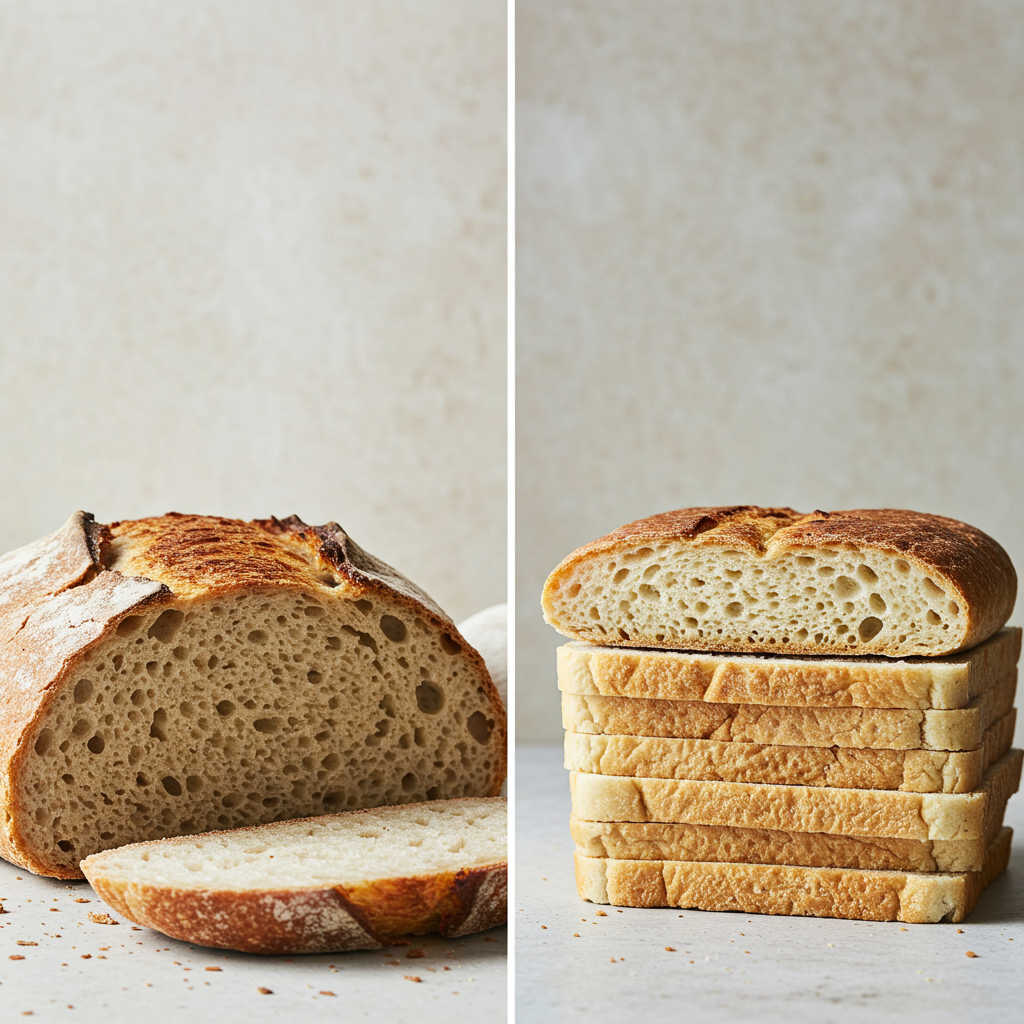Step into any modern supermarket, and you face a staggering variety of bread. While incredibly convenient, this abundance can make choosing a truly healthy loaf feel overwhelming. Yet, the type of bread you eat daily significantly impacts your nutrition and overall well-being. Understanding the differences between popular options like ubiquitous white sliced bread and traditional sourdough is key to making better dietary choices.
For years, many people have gravitated towards the convenience and affordability of standard supermarket white bread. Its soft texture and long shelf life make it a kitchen staple. However, a growing awareness of how food is produced, particularly concerning Ultra-Processed Foods (UPFs), has led consumers to question what’s really in their daily loaf. This scrutiny shines a spotlight on industrial baking methods and the ingredients used.
In stark contrast stands traditional sourdough. Made through a slow fermentation process using a live starter of wild yeast and bacteria, sourdough offers a distinct tangy flavour and often a chewier texture. Its rising popularity, sometimes linked to pandemic-era home baking resurgence, highlights a desire for simpler, perhaps healthier, food. But beyond taste and trend, does the way bread is made genuinely affect its nutritional value?
Understanding the Production Process
Not all bread is created equal, largely due to differing production methods.
The Chorleywood Method Explained
Developed in the UK in the late 1950s, the Chorleywood Bread Process revolutionized baking. The goal was to produce bread much faster and more cheaply, utilizing lower-protein wheat. This method involves adding hard fats, extra commercial yeast, and various chemical additives like enzymes (to break down starch), oxidants (to strengthen the dough), and emulsifiers (to help ingredients combine). The mixture is then kneaded intensely at high speed.
This technique slashed production time from hours to minutes and extended shelf life considerably. Today, estimates suggest around 80% of bread consumed in the UK still uses this method. While initially intended to aid small bakers, industrial-scale bakeries widely adopted it, ironically challenging smaller, traditional operations. The speed and efficiency come at a nutritional cost for many resulting loaves.
The Ancient Art of Sourdough
Sourdough baking follows a time-honored process centered around a “starter.” This starter is a living culture created and maintained by mixing flour and water, allowing naturally present wild yeast and lactic acid bacteria (LAB) to multiply. Instead of commercial yeast providing the sole lift, this microbial community does the work.
The process typically involves several steps: mixing ingredients (flour, water, salt, starter), kneading, a long initial fermentation (bulk rise), shaping, and a final rise (proofing). This can take anywhere from 8 to over 36 hours, often incorporating periods of slow, cold fermentation (like overnight refrigeration) to enhance flavour and digestibility. The wild yeast and LAB work together, fermenting sugars and producing carbon dioxide bubbles that make the bread rise, alongside organic acids that give sourdough its characteristic tang and contribute to its health benefits.
The Health Impact: Sourdough vs. White Sliced
The difference in production methods translates into significant nutritional distinctions and health effects.
The Benefits of Traditional Sourdough
Sourdough’s slow fermentation process offers notable health advantages:
Improved Digestibility: The LAB in sourdough pre-digest parts of the flour. Fermentation breaks down certain difficult-to-digest sugars called FODMAPs, potentially making sourdough easier on the stomach for individuals sensitive to these compounds.
Enhanced Nutrient Absorption: Grains contain phytic acid, an “antinutrient” that can bind to minerals like iron, zinc, magnesium, and phosphorus, reducing their absorption. Sourdough’s acidic environment, created by LAB, helps break down phytic acid more effectively than standard yeast fermentation. This makes the minerals naturally present in the flour more bioavailable to your body.
Better Blood Sugar Control: Research suggests sourdough often has a lower glycemic index (GI) than many other breads. The fermentation process and the organic acids produced can alter how quickly carbohydrates are absorbed, leading to a slower, more gradual rise in blood sugar levels after eating, compared to the rapid spike sometimes seen with refined white bread.
Fuel for Your Gut: The natural fermentation process can produce prebiotics. These are indigestible fibres that feed beneficial bacteria in your gut microbiome, supporting digestive health. Fibre and beneficial compounds called polyphenols in the flour also act as fuel for these microbes.
Potential for Increased Satiety: Some studies indicate that sourdough might help you feel fuller for longer, potentially aiding weight management, though findings in this area are not entirely consistent across all research.
It’s important to note that while the fermentation process can partially break down gluten proteins, traditional sourdough made from wheat, barley, or rye is not gluten-free. Individuals with celiac disease or severe gluten sensitivity should still avoid these types.
The Challenges of Many White Sliced Breads
Many mass-produced white sliced breads fall into the category of Ultra-Processed Foods (UPFs). This classification often stems from the presence of industrial additives aimed at speeding production, extending shelf life, or enhancing texture and appearance, rather than providing inherent nutritional value.
The Chorleywood method, relying on chemical aids, contributes to many loaves being considered UPFs. Some additives used globally, though not always in every country, have raised health concerns. For instance, potassium bromate, sometimes used in the US to strengthen dough and increase loaf volume, is considered a possible human carcinogen.
Identifying UPFs can be tricky by label alone. A common rule of thumb suggested by some academics is that if a food contains five or more ingredients, especially those you wouldn’t typically stock in a home kitchen (like emulsifiers, specific gums, or modified starches), it likely qualifies as a UPF. While not all supermarket bread is necessarily “bad,” a significant portion is mass-produced using processes that strip away natural nutrients and add potentially questionable ingredients. High consumption of UPFs is linked to various health issues, although it is also cautioned that the UPF category is broad and doesn’t mean all supermarket bread should be entirely vilified.
Embracing the Power of Wholegrain
Beyond the sourdough vs. conventional debate, the type of flour used is paramount. Choosing wholegrain bread offers substantial health benefits over bread made with refined white flour.
A wheat grain consists of three main parts: the bran (the fibrous outer layer), the germ (the nutrient-rich embryo), and the endosperm (the starchy inner section). White flour production removes the bran and germ, leaving only the endosperm. Wholegrain flour, however, uses all three parts.
This inclusion makes wholegrain bread a nutritional powerhouse. It contains significantly more dietary fibre, essential vitamins (like B vitamins, Vitamin E, folate), minerals (such as magnesium, iron, zinc), protein, healthy fats, and antioxidants (polyphenols) compared to refined white bread.
Consuming wholegrain bread is linked to a reduced risk of chronic diseases, including heart disease and certain cancers. The high fibre content supports a healthier gut microbiome and aids digestion. Fibre also slows down the absorption of sugar into the bloodstream, preventing rapid spikes and crashes that can lead to increased hunger. This steady release of energy can help with weight management; some studies show a link between higher wholegrain intake and lower body mass index (BMI) and reduced belly fat.
Be mindful that “brown bread” or “seeded bread” isn’t automatically wholegrain. Colouring or adding seeds to refined white flour results in brown or seeded loaves that lack the full nutritional profile of genuine wholegrain bread. Always check the ingredients list to ensure “whole wheat,” “whole grain,” or similar is listed as the first ingredient.
Making Healthier Bread Choices
Navigating the bread aisle can feel daunting, but armed with knowledge, you can make more informed decisions.
Spotting Healthy Supermarket Bread
Look beyond the marketing claims. Turn the loaf over and read the ingredients list. Prioritize breads with minimal, recognizable ingredients. A strong indicator of a healthier loaf is seeing “whole grain” or “whole wheat” listed as one of the first* ingredients.
Look for breads with added seeds and nuts; these boost fibre, healthy fats, and protein. Aim for loaves offering at least 3-5 grams of fibre and ideally 4+ grams of protein per slice. Sprouted grain breads are another excellent option, as sprouting can further enhance nutrient availability and digestibility. Some supermarket chains now offer packaged sourdough made with simpler ingredients, distinguishable from highly processed sliced breads.
While convenience and cost are factors, even small changes matter. Swapping from refined white bread to wholegrain is a significant positive step. If cost is a barrier for artisan sourdough, explore supermarket options carefully. Freezing bread is also an effective way to extend the life of healthier loaves, reducing waste and ensuring you always have a good option on hand.
The Future of Better Bread
Exciting research is underway to bridge the gap between taste preference and nutritional value. Scientists are developing methods to create white-looking and tasting bread that retains the health benefits of wholemeal. This involves incorporating bran, germ, and nutrient-rich additions like pulses (peas, beans) and alternative grains (teff, sorghum, millet) into refined flour in a way that maintains a desirable texture and flavour profile. While these innovations may take time to reach the market, they offer hope for even healthier, widely available options in the future.
Frequently Asked Questions
Why is sourdough bread considered easier to digest than many other breads?
Traditional sourdough undergoes a long fermentation process using lactic acid bacteria (LAB). These bacteria help pre-digest carbohydrates, including certain difficult-to-absorb sugars called FODMAPs, making them easier for some people to process. The fermentation also reduces phytic acid, improving mineral absorption, and can partially break down gluten proteins, though it’s still not suitable for those with celiac disease.
How can I identify a healthy loaf of bread when shopping at the supermarket?
Look closely at the ingredients list. Prioritize breads where “whole grain” or “whole wheat” is listed as one of the first ingredients. Check the nutritional information panel; healthy breads typically offer at least 3-5 grams of fibre and preferably 4 or more grams of protein per slice. Avoid loaves with a long list of unfamiliar additives, sweeteners like added granulated sugar high up on the list, or artificial preservatives.
Is all supermarket bread unhealthy ultra-processed food (UPF)?
No, not all supermarket bread is necessarily unhealthy UPF. While many mass-produced loaves made with the Chorleywood method and numerous additives are classified as UPFs, some options exist with simpler ingredient lists. These might include certain packaged sourdoughs with minimal ingredients or specific brands focusing on whole grains, sprouted grains, or traditional methods. Checking the ingredients is key to finding less processed options.
Conclusion
Choosing the right bread involves balancing taste, cost, convenience, and health. While artisan sourdough and high-quality wholegrain loaves offer significant nutritional advantages, not everyone has the time, budget, or access for these. The key takeaway is making conscious choices. By understanding the differences in production methods, recognizing the benefits of wholegrain and fermentation, and learning to read ingredient labels effectively, you can navigate the supermarket bread aisle to find options that better support your health goals, one slice at a time.




